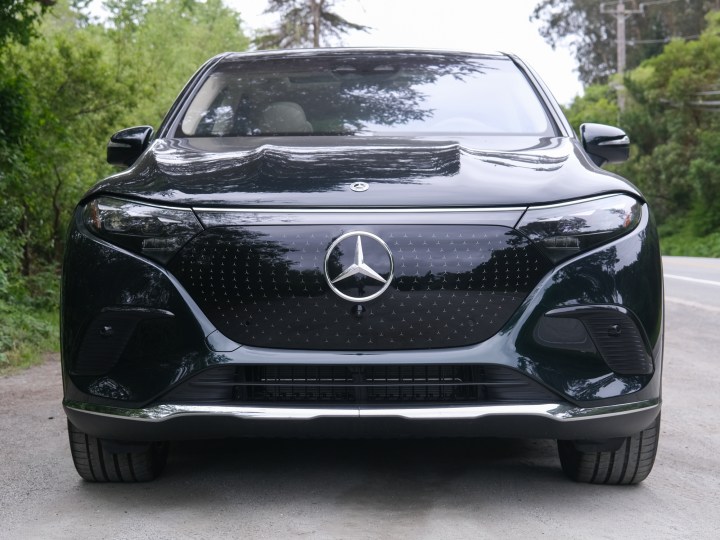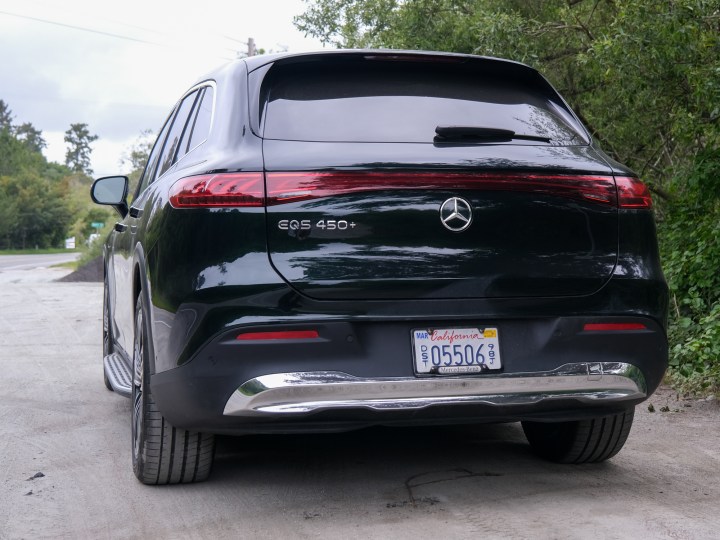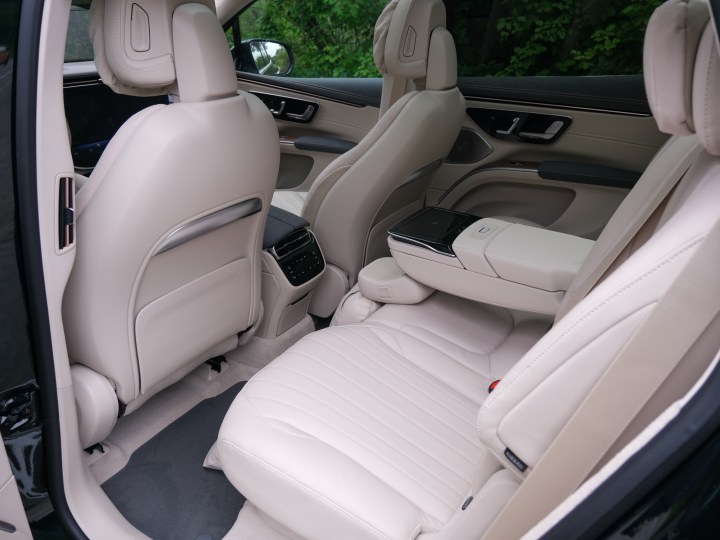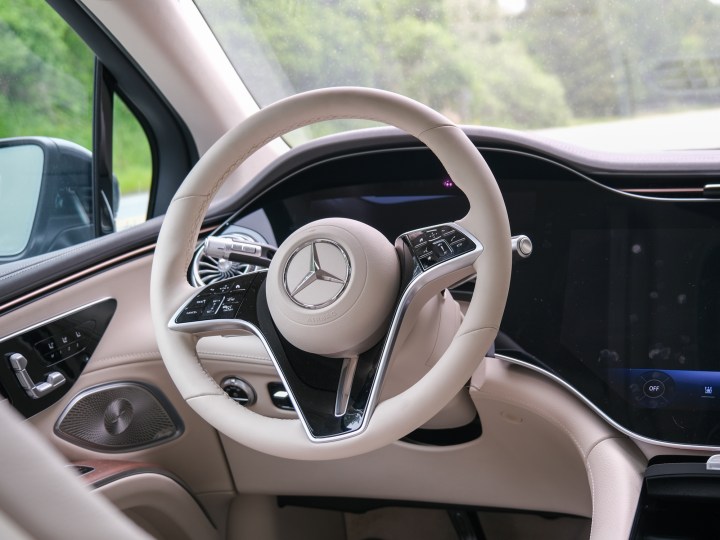2024 Mercedes-Benz EQS SUV review: built for comfort
MSRP $104,400.00
“The 2024 Mercedes-Benz EQS SUV has soft suspension and mostly responsive steering, though you’d be hard-pressed to call this a driver’s car.”
Pros
- Luxurious interior
- Solid range
- Relatively powerful
- Ample passenger room
Cons
- Controversial exterior design
- Slightly mushy suspension and steering
- Expensive
The luxury carmakers, like BMW and Mercedes-Benz, were quick to adopt vehicle electrification. The original Mercedes-Benz EQS was first produced in 2021, and since then, the company has radically expanded its lineup of EVs — to the point where there should be something in the lineup for anyone who can afford to spend luxury vehicle-level cash.
Over the past week, I’ve had the opportunity to use the Mercedes-Benz EQS 450+ Pinnacle SUV, which starts at $104,400, as my daily driver. It’s essentially the larger version of the relatively popular EQS sedan, and it sits in the middle of the EQS SUV range for 2024. That’s not to say it’s slow, though — on the contrary, the EQS SUV continues the Mercedes-Benz tradition of going fast, comfortably.
Design and interior
The design of the 2024 iteration of the EQS SUV is nothing new — it’s generally the same design that the car has had for the past few years. That’s not a bad thing in and of itself, though the design language of Mercedes’ electric vehicles hasn’t been without controversy.

I will say, I prefer the design of the EQS SUV to the design of the EQS sedan. Something about the higher roofline and existence of some angles in the design makes it look a little more natural than the egglike EQS sedan.
The front of the EQS SUV showcases Mercedes’ attempt at building an electric car’s face. It’s not the faceless look that some EVs have gone for — which is a good thing. But it also feels a little like a transition look. The front has a large curved nose that’s built for aerodynamics, with a big Mercedes-Benz logo in the middle of it. It’s flanked by two slim, slanted headlights, and situated above a slim grille for air intake.

The rest of the car’s design is a little more traditional. It has a high roofline that curves down toward the end, and a long light bar at the back that houses the taillights.
I’m not in love with the overall design of the 2024 EQS SUV, but I certainly like it better than that of the sedan, and I can see why some might like its style.
The interior of the EQS SUV is another story. It’s luxurious, comfortable, and built with premium materials. Like other EQS vehicles, it offers a series of displays throughout, and the seats and steering wheel are adorned with a nice stitched leather. There are plush pillows on the headrest, too, and while there is some plastic in the interior build, it doesn’t necessarily feel overly cheap or of low quality. I do wish there was less plastic, but it’s not really a huge deal. Other touches like accent lighting and plenty of storage help contribute to a very comfortable, premium-feeling interior. And, there’s a big panoramic sunroof, at least in our model.

The EQS SUV offers 31 cubic feet of storage behind the second row in five-seater models. In seven-seater models, you’ll get 28 cubic feet of storage behind the second row, however, there’s only 7 cubic feet when the third row is up and in use.
Tech, infotainment, and driver assist
The EQS SUV offers a number of displays throughout the interior. There’s a 12.8-inch central infotainment screen, a bright instrument display, and an infotainment display for the front passenger. There’s even a screen in the pull-down middle seat for rear passengers.
The car is loaded with Mercedes’ own infotainment system, MBUX, and it’s pretty well-designed. It’s better than many of the infotainment systems built by other legacy automakers, but it’s still not as responsive or as easy to navigate as that in the new crop of software-defined vehicles like Tesla and Rivian. Thankfully, the car also supports CarPlay and Android Auto, through a wireless connection, so you can rely on your phone for things like mapping and entertainment if you want. There’s an optional heads-up display, which is a nice touch, but hardly ultra-important.

Like other EVs in 2024, the car puts most of the climate controls in the infotainment display, which I don’t love. Thankfully, these controls are relatively easy to access no matter what screen you’re on — but it will still involve taking your eyes off the road more than physical controls would.
The EQS SUV comes with a range of driver-assist features. Standard are things like adaptive cruise control and automatic emergency braking. Drivers will also get things like a lane-keeping assistant and even an automatic parking feature, which is quite handy. You can get a near self-driving experience on the highway with these features, however, the car has a driver-attention monitor and you’ll need to keep your hands on the wheel.
Driving experience
Driving the Mercedes-Benz EQS SUV could be described as “comfortable.” That’s a good thing. It has soft suspension and mostly responsive steering, though you’d be hard-pressed to call this a “driver’s car.” This is a car for those who want to limit bumps and take turns nice and comfortably.
There are two powertrain options on the EQS SUV. The EQS 450+ SUV comes with a 335-horsepower electric motor that only powers the rear wheels, while the EQS 580 SUV has two motors that power the rear and front wheels, and they combine to deliver 536 horsepower.

Even the rear-wheel drive model, which is what I drove, was relatively powerful and quick. It won’t reach those super-quick acceleration speeds, but it has the power to easily overtake other vehicles on the highway and get up to speed at a comfortable pace. I reached 60 miles per hour from a standstill in a little over 7 seconds, which is fine — but again, if you want that roller coaster-like acceleration, you might want to upgrade to the dual-motor variant of the car.
Range and charging
The Mercedes-Benz EQS SUV has a 107.8 kilowatt-hour battery no matter which variant you get, and the range is pretty good depending on the model you go for. The single-motor model, which we had, has a range of up to 305 miles, while the dual-motor variant has a range of up to 285 miles.

This range is about average for EVs in 2024. I’m hoping we’ll start to see some serious improvements in EV range, whether that come from solid-state batteries or other technological advancements. The Lucid Air starts at a much lower price than the EQS SUV, but even the lowest-range version of it offers a huge 394 miles — and others get much higher. Regardless, the 305-mile range of the EQS 450+ SUV still isn’t bad, and most will find it to be more than enough.
The car charges at up to 200kW, which isn’t as fast as I would have liked to have seen. There are much cheaper cars that charge at 350kW, allowing them to get a full charge in under 20 minutes. The EQS 450+ SUV will get from 10% to 80% in 31 minutes, with a fast charger that supports its fastest charging speed.
How DT would configure this car
The 2024 EQS SUV is a solid vehicle no matter which model you go for. However, despite the fact that I have only driven the lower-end EQS 450+ model, most people will probably want to upgrade to the EQS 580, which packs a more powerful punch without sacrificing that much range. Depending on your preferences, it may be worth considering a model with extra touches — like the heads-up display and panoramic sunroof.
It’s also worth considering alternatives. For example, the BMW iX offers better performance at a lower price, with similar tech features and a similar range. But if you are a big Mercedes-Benz fan, you’ll love what’s on offer from the 2024 Mercedes-Benz EQS SUV.
Editors’ Recommendations
Credit: Source link
